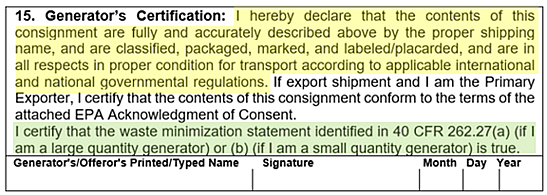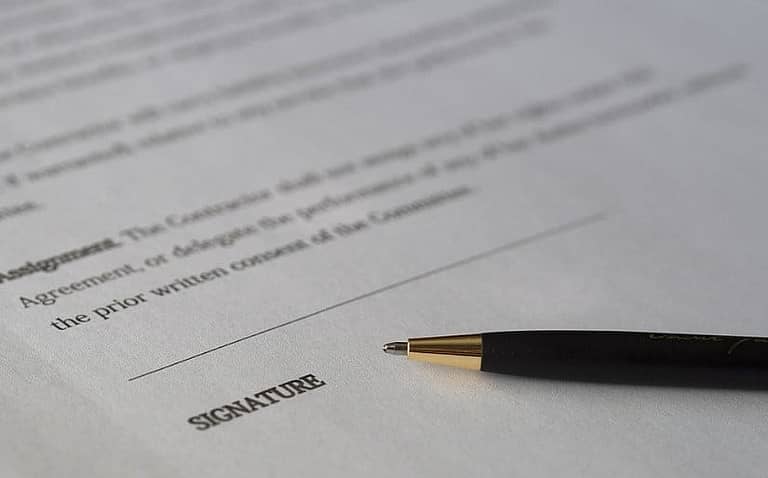With few exceptions, when offering or transporting hazardous materials to, from, or within the United States, specific documentation must accompany the shipment. These shipping papers may be in the form of a bill of lading, a hazardous waste manifest, or even a shipper’s declaration. In the US, shipping papers must meet Department of Transportation (DOT) requirements. Hazardous waste manifests are used to comply with both DOT and Environmental Protection Agency (EPA) regulations when shipping hazardous waste. When transporting hazardous materials (also known as dangerous goods) by air, a Shipper’s Declaration is often completed.
Each of these forms has a certification statement included, and which document you are signing dictates which training you need. To sign a shipping paper for hazmat ground transport in the US, employers must certify that the employee signing has received the appropriate 49 CFR Subchapter C, hazardous materials regulations (HMR) training as described in Subpart H. In order to sign off on a hazardous waste manifest, you need training on the hazardous waste management regulations found in 40 CFR Subchapter I, which are commonly known as the RCRA rules, in addition to those from the DOT. If you are shipping hazmat on an aircraft or vessel, specific DOT training for these modes of transport is required. Supplemental training is needed for those shipping dangerous goods internationally. Even for domestic air shipments, additional training is likely to include International Civil Aviation Organization (ICAO) or International Air Transport Association (IATA) rules.

Every time you sign a shipping paper for hazardous materials, you “hereby declare that the contents of this consignment are fully and accurately described above by the proper shipping name and are classified, packaged, marked and labeled/placarded, and are in all respects in proper condition for transport according to applicable international and national government regulations.”
Which means, you are guaranteeing that:
- The package was properly selected, prepared, and closed so that everything inside will stay inside throughout transportation.
- All the required information is correctly marked and labeled on the package.
- If applicable, the transporter was provided with the appropriate placards to post on the vehicle for the shipment.
- The shipping documentation is 100% accurate and the necessary emergency response information is included.

If that DOT shipping paper happens to be a manifest, your signature indicates that the company is minimizing the amount of hazardous waste that it generates. The text found in 40 CFR 262.27(a) states:
- As a small quantity generator (SQG): “I have made a good faith effort to minimize my waste generation and select the best waste management method that is available to me and that I can afford.”
- As a large quantity generator (LQG): “I have a program in place to reduce the volume and toxicity of waste generated to the degree I have determined to be economically practicable and I have selected the practicable method of treatment, storage, or disposal currently available to me which minimizes the present and future threat to human health and the environment.”
By signing a shipper’s declaration, you are attesting to the DOT requirements as well as international regulations and air transport restrictions. There is also a warning listed on the declaration that subjects you to legal penalties if your shipment is not compliant.

Before you sign off on any hazardous material, hazardous waste, or dangerous goods shipping papers, make sure you understand what you are certifying by signing and that you have the proper authority and training to do so!
For help meeting your DOT and RCRA training needs, check out the Safety Partners Training and Professional Development page.
If you have questions or need more information, we can help – Contact us!
This blog was written by Kim E. Folger, Safety Partners’ Training and Development Manager


